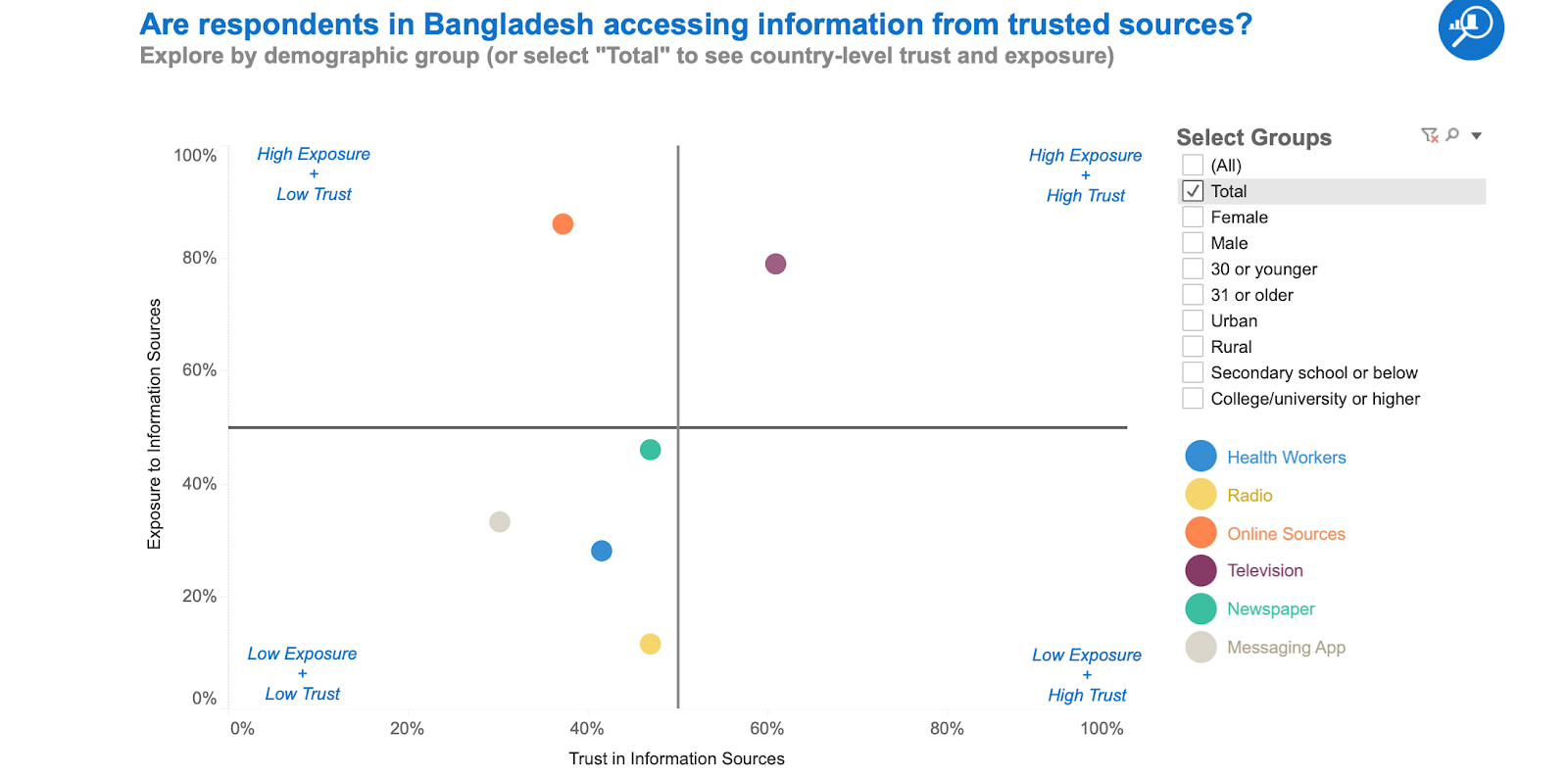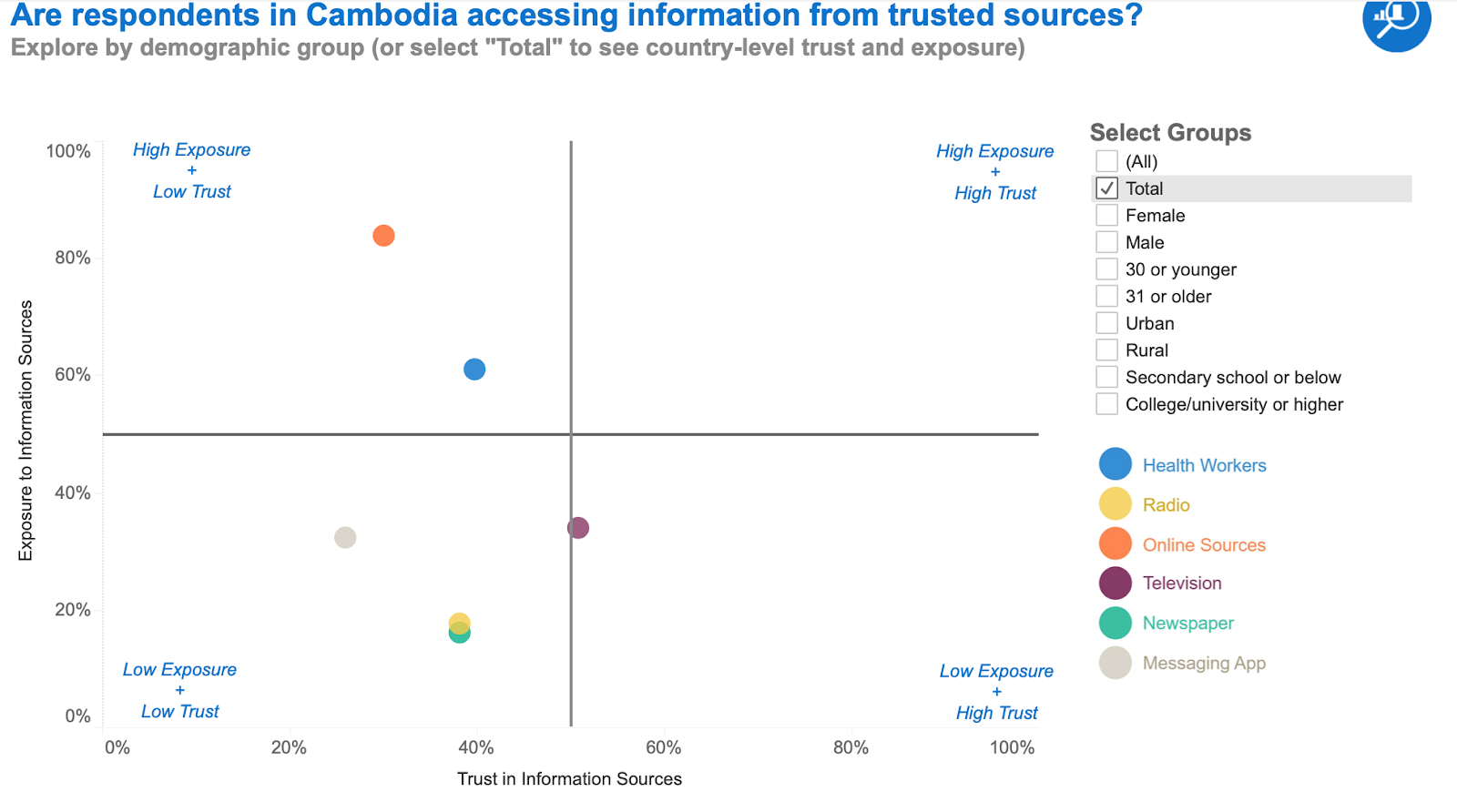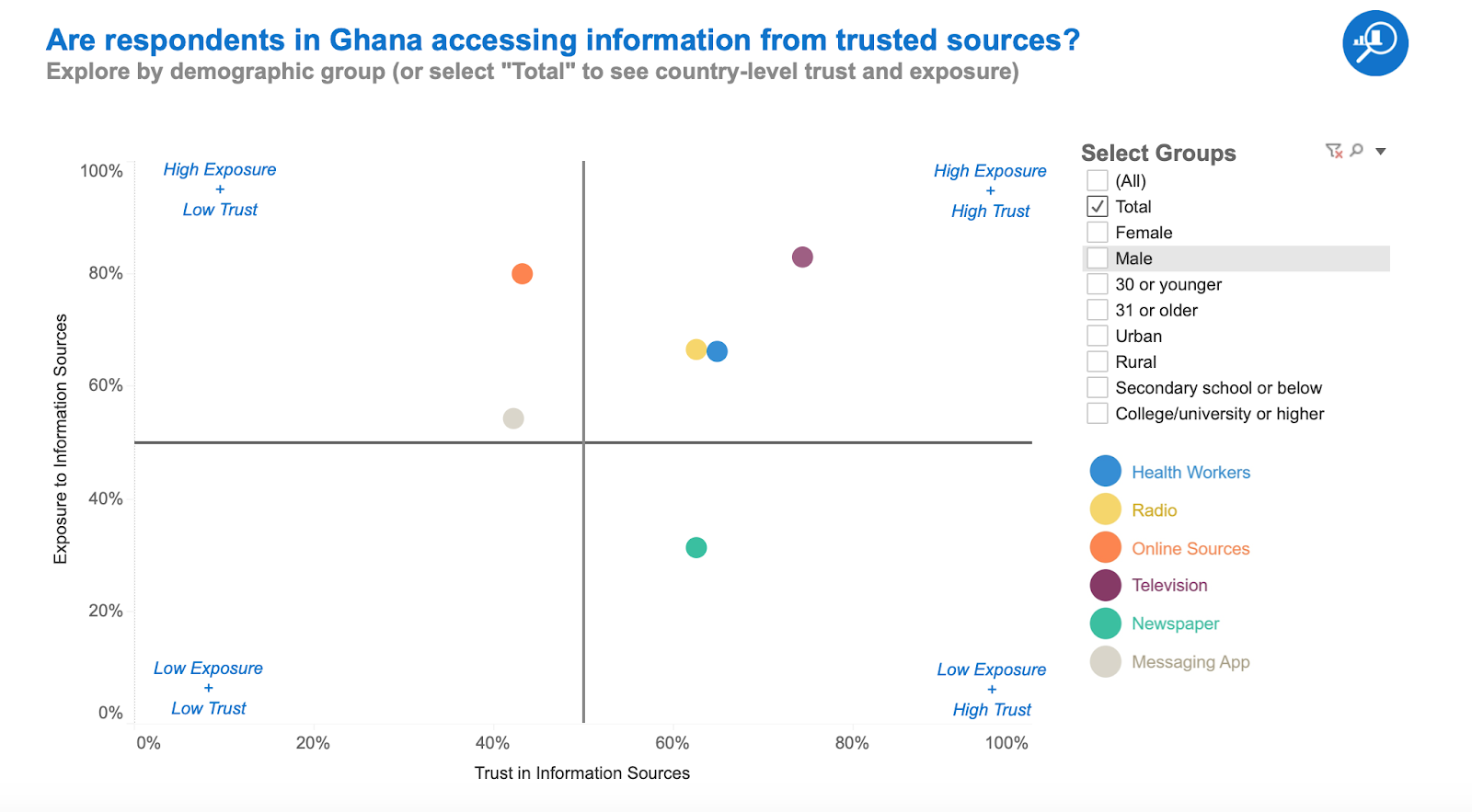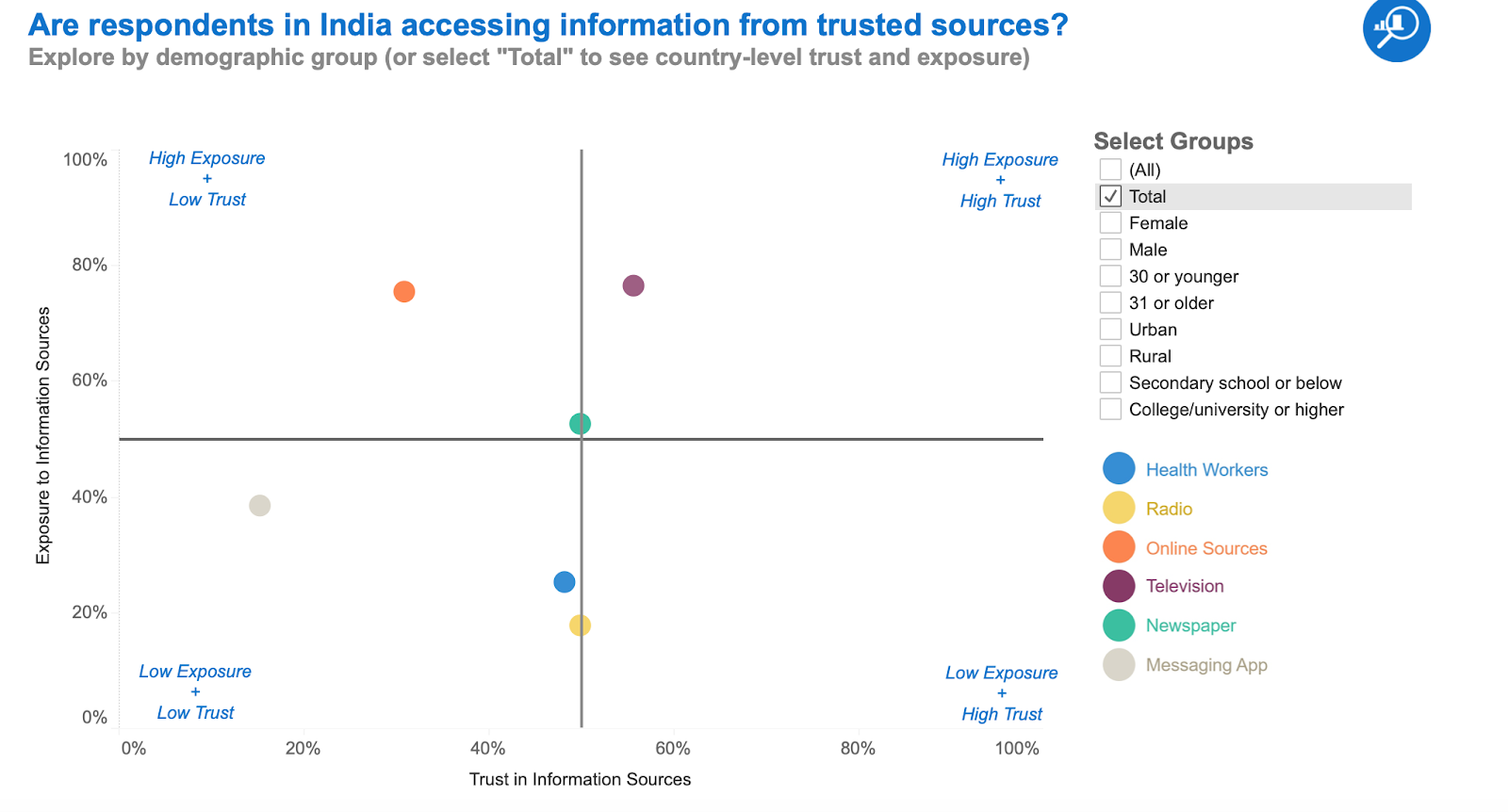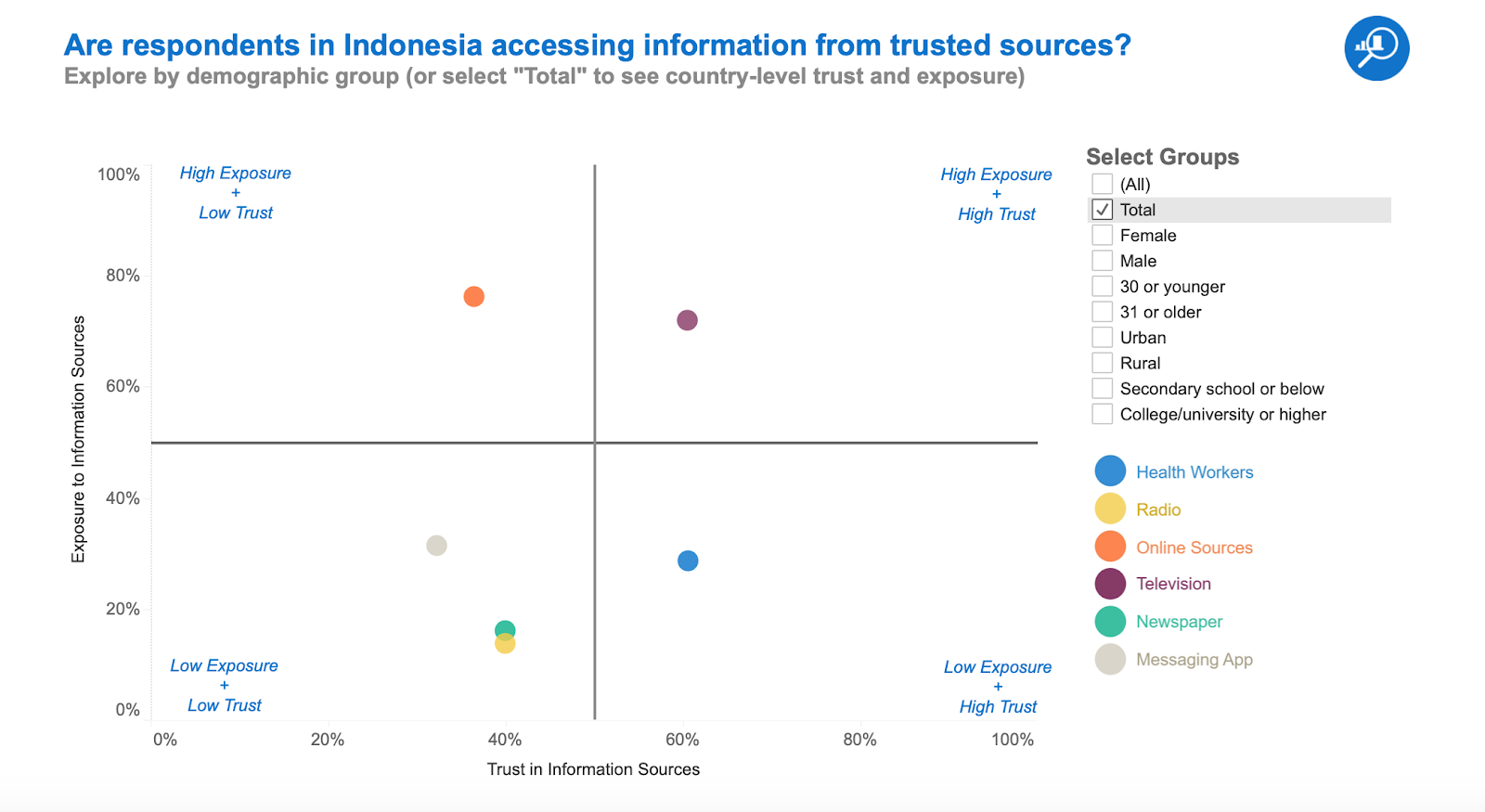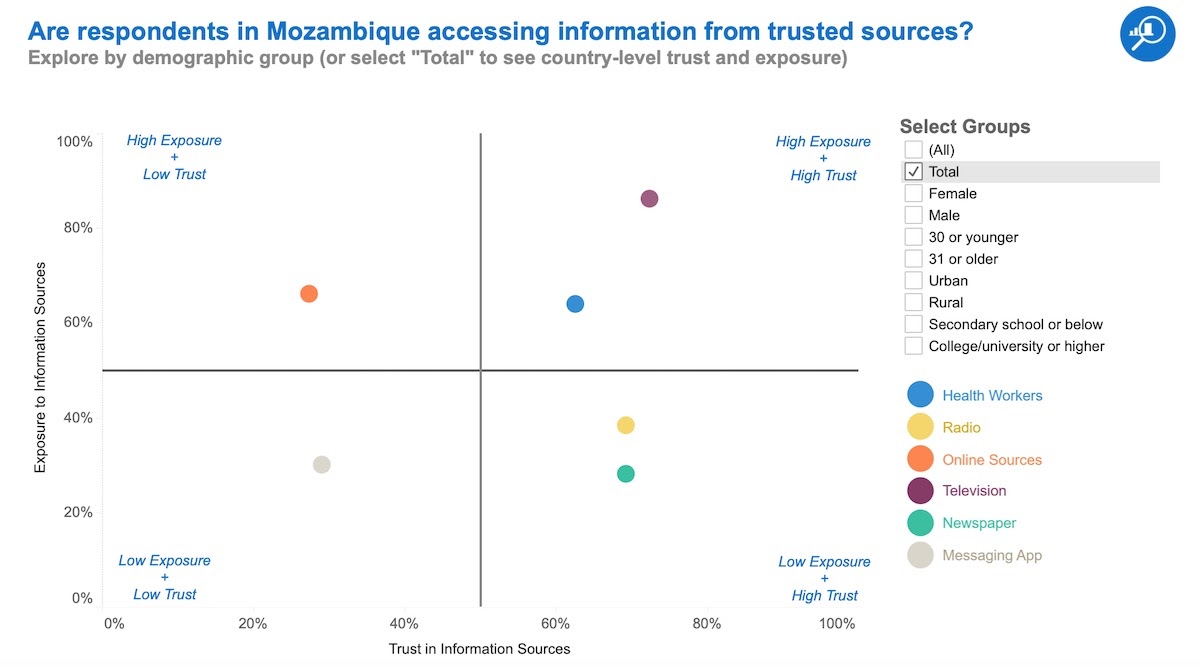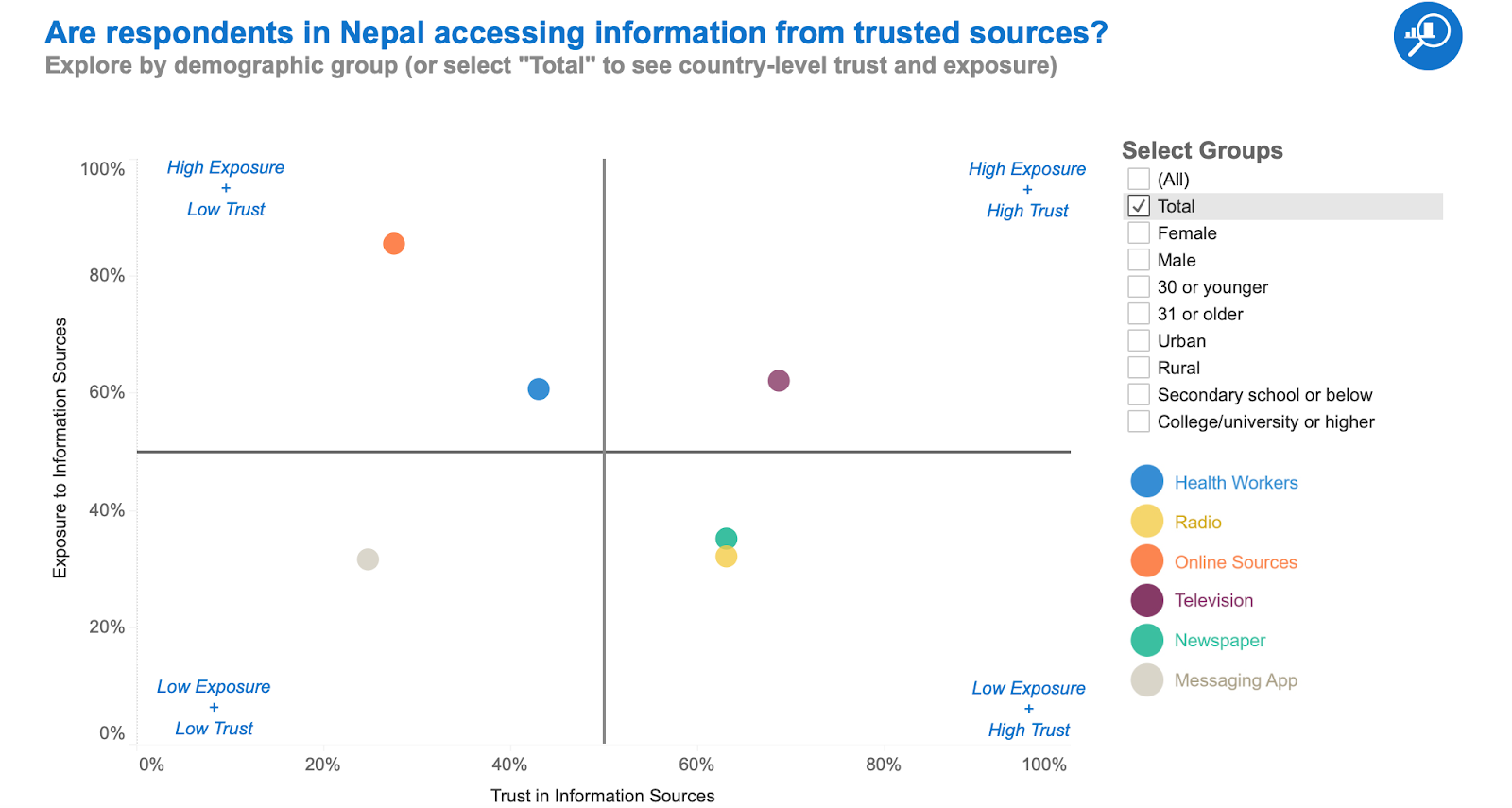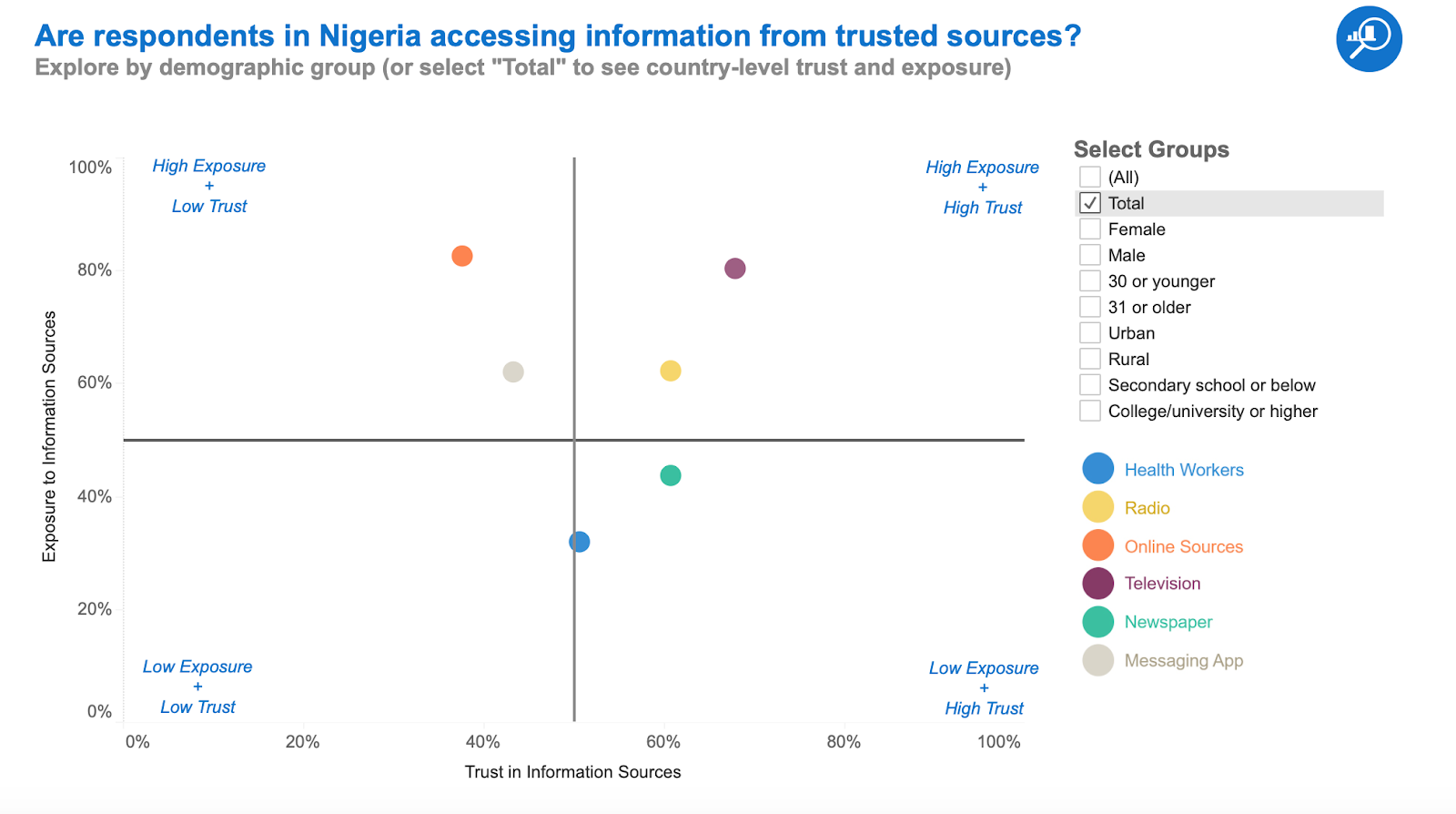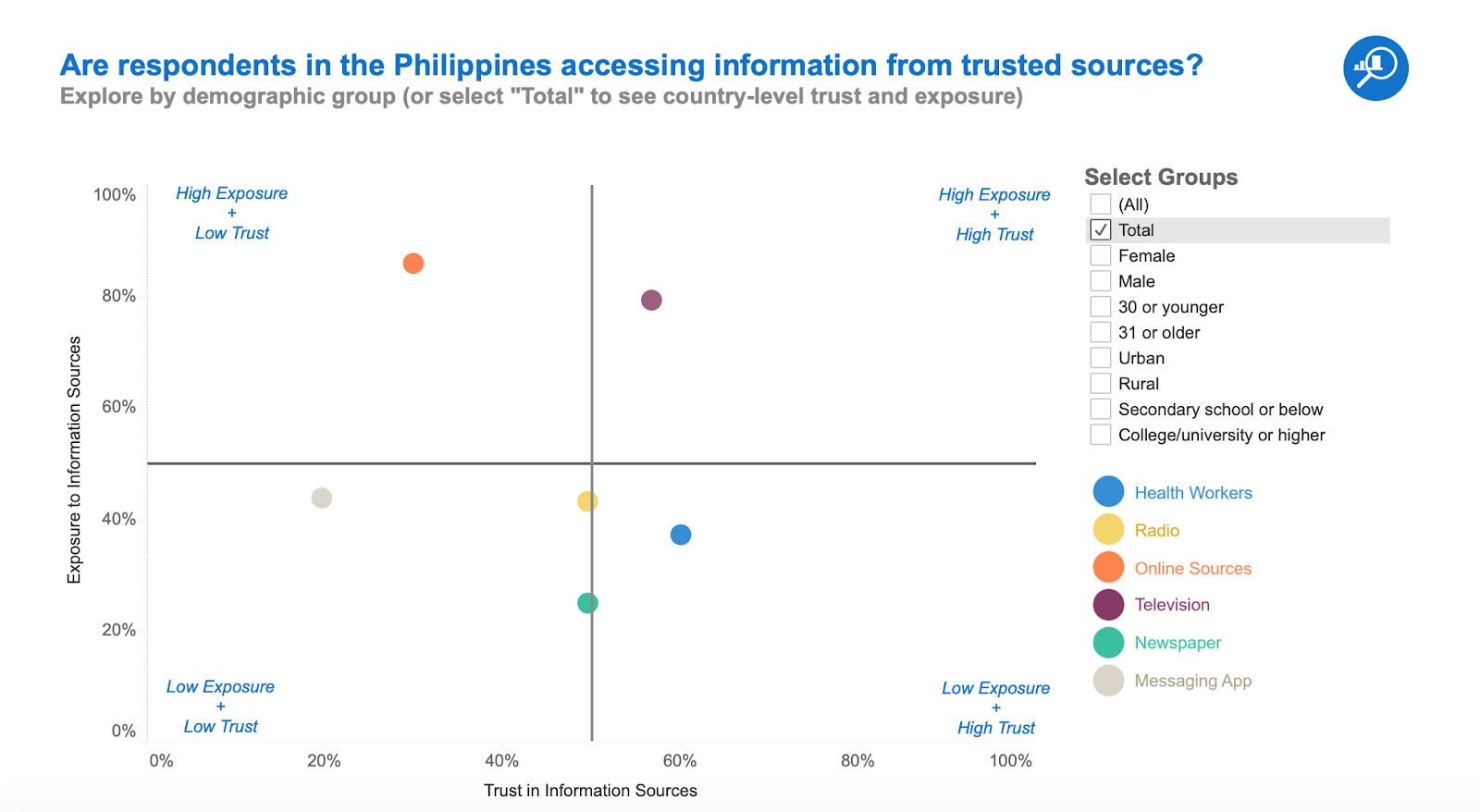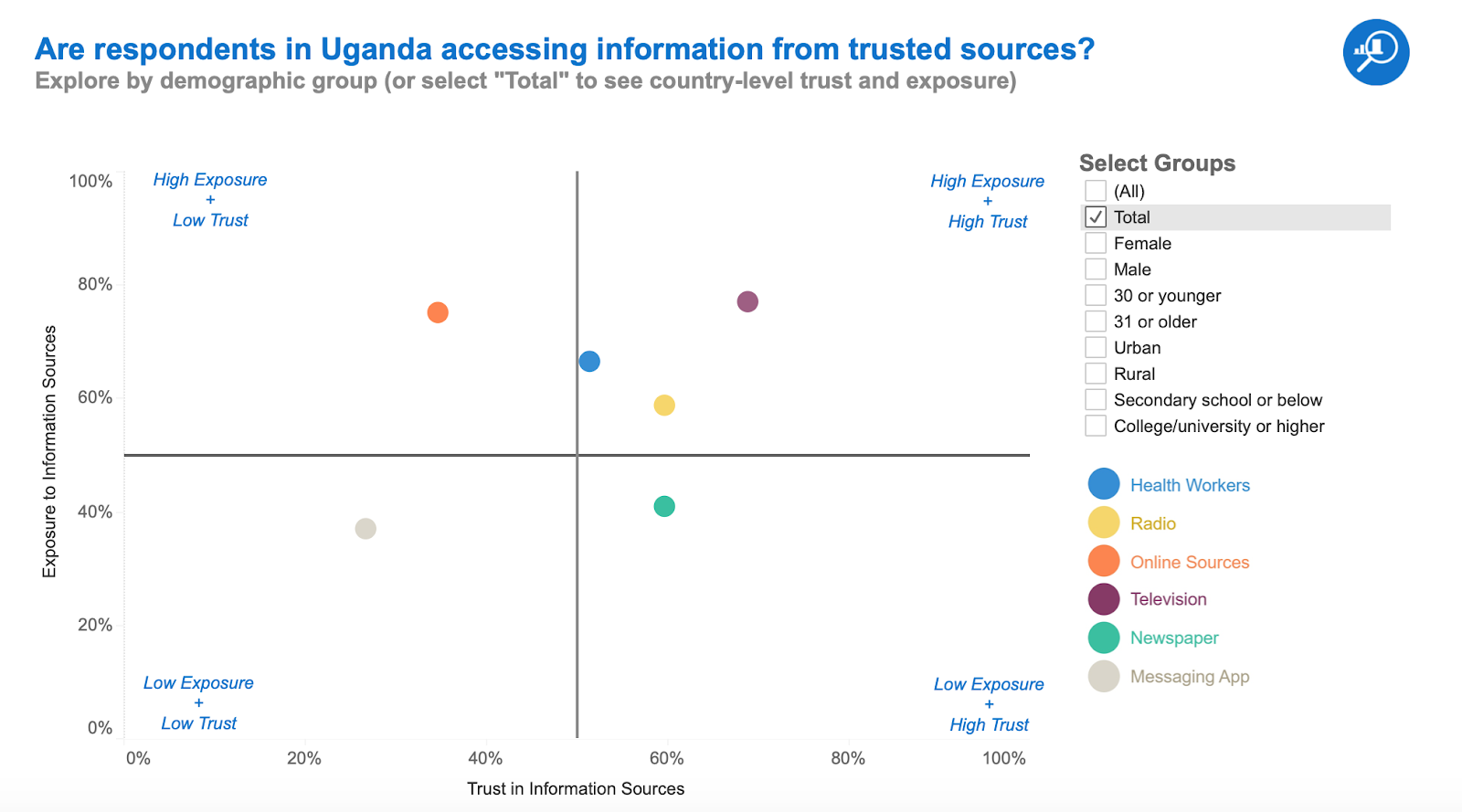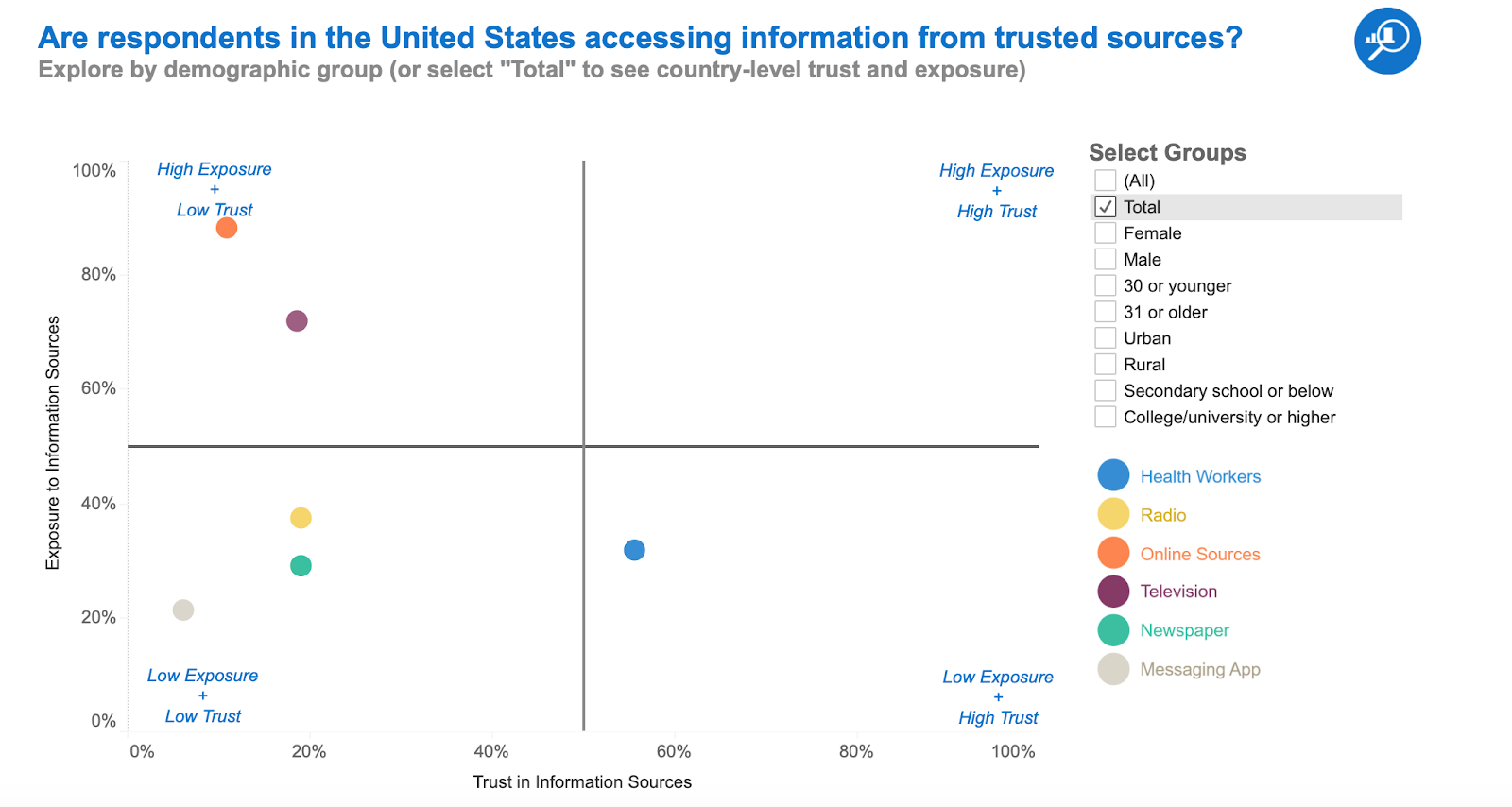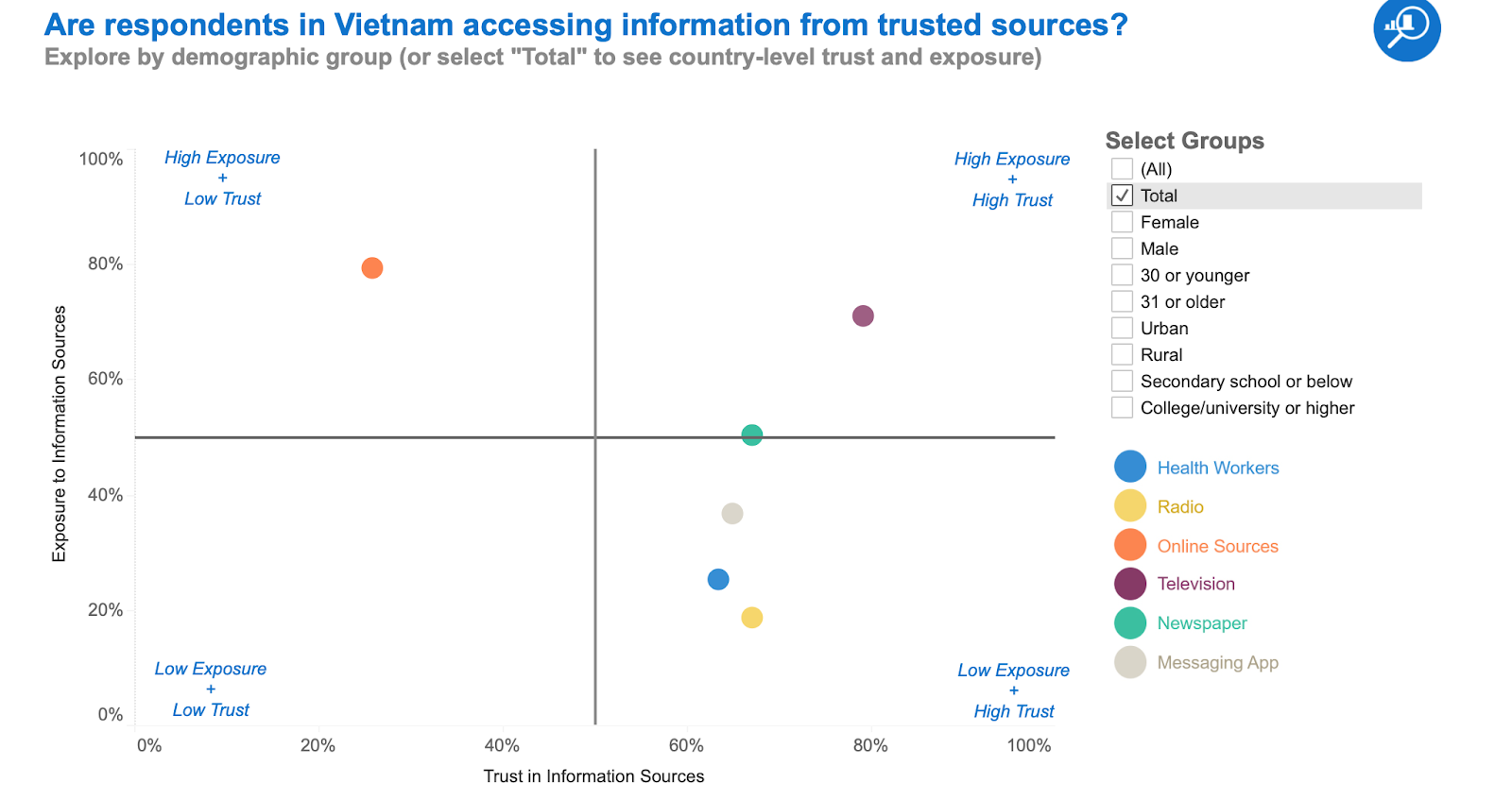The KAP COVID Dashboard developed by Johns Hopkins Center for Communication Programs (CCP) presents data from a global survey of knowledge, attitudes, and practices around COVID-19. For the next five weeks, relevant data from the dashboard specific to Breakthrough ACTION will be highlighted. This information can be used by public health professionals and policymakers to design programs, promote messages, and help focus their behavior change efforts.
This first set of data focuses on TRUST. For each country below, you’ll see the outlets, channels, and individuals that garner the most trust among survey participants. Please feel free to share within your social networks and/or adapt the posts below to your country context by finding your country’s data on the dashboard.
These findings come from global COVID-19 behavior surveys conducted in July 2020 in 67 countries from more than 300,000 people who chose to participate in a survey promoted on Facebook. Researchers from MIT collected the data and CCP analyzed and presented the data on an easy-to-use dashboard. This study of knowledge, attitudes, and practices around COVID-19 is a collaboration among CCP, Facebook Data for Good, and MIT. The World Health Organization and Global Outbreak Alert and Response Network served as advisors.
| Country and Social Media Image | Facebook Post | Twitter Post |
|---|---|---|
| Bangladesh | In Bangladesh, television and the internet provide the greatest amount of COVID-19 information. The difference? Far more Bangladeshis trust information from television (and other sources) than what they read on the internet. Use the KAP COVID Dashboard to learn more about COVID-19 behaviors and attitudes in Banglades. https://ccpnews.link/kapcovid_bd
@WHO @Goarn @MITnews @Facebook @JohnsHopkinsCCP |
In Bangladesh, television and the internet provide the greatest amount of #COVID19 info. The difference? Far more Bangladeshis trust info from TV. Explore the @JohnsHopkinsCCP #KAPCOVID Dashboard: https://ccpnews.link/kapcovid_bd
@WHOGOARN @MIT @Facebook |
| Cambodia | Cambodians get most of their COVID-19 information from the internet, but only 34% trust this source. Use the KAP COVID dashboard to learn more about COVID-19 behaviors and attitudes in Cambodia. https://breakthrough.link/kapcovid_cm @WHO @Goarn @MITnews @Facebook @JohnsHopkinsCCP |
Cambodians get most of their #COVID19 info from the internet, but only 34% trust this source. Explore more COVID-19 behaviors and attitudes on the @JohnsHopkinsCCP #KAPCOVID Dashboard: https://breakthrough.link/kapcovid_cm @WHOGOARN @MIT @Facebook |
| Cameroon | In Cameroon, television is the most trusted and commonly accessed source of information about COVID-19. Where do you get information about the pandemic? Use the KAP COVID Dashboard to learn more about COVID-19 behaviors and attitudes in Cameroon. https://ccpnews.link/kapcovid_cr @WHO @Goarn @MITnews @Facebook @JohnsHopkinsCCP |
Where do you get your info about the #COVID19 pandemic? In Cameroon, TV is most commonly accessed and trusted. Explore more COVID-19 behaviors and attitudes on the @JohnsHopkinsCCP #KAPCOVID Dashboard: https://ccpnews.link/kapcovid_cr @WHOGOARN @MIT @Facebook |
| Côte d’Ivoire | In Côte d’Ivoire, health workers and television are almost equally trusted sources of information. While a little over half of people report contact with health workers, 79% report exposure to TV. Use the KAP COVID Dashboard to learn more about COVID-19 behaviors and attitudes in Côte d’Ivoire. https://ccpnews.link/kapcovid_ci @WHO @Goarn @MITnews @Facebook @JohnsHopkinsCCP |
In Côte d’Ivoire, health workers and television are almost equally trusted sources of #COVID19 information. Explore more COVID-19 behaviors and attitudes on the @JohnsHopkinsCCP #KAPCOVID Dashboard: https://ccpnews.link/kapcovid_ci
@WHOGOARN @MIT @Facebook |
| Ghana | In Ghana, people are equally exposed to information from online sources and television. The difference? Television is a more trusted source for information. While 74% of people trust TV only 43% of people trust online sources. Use the KAP COVID Dashboard to learn more about COVID-19 behaviors and attitudes in Ghana. https://ccpnews.link/kapcovid_gh @WHO @Goarn @MITnews @Facebook @JohnsHopkinsCCP |
In Ghana, TV and the internet provide the most #COVID19 info. The difference? TV is a more trusted source. Explore COVID-19 behaviors and attitudes on the @JohnsHopkinsCCP #KAPCOVID Dashboard: https://ccpnews.link/kapcovid_gh
@WHOGOARN @MIT @Facebook |
| India | In India, people are equally exposed to information from online sources and television. The difference? Television is a more trusted source for information. While 56% of people trust TV, only 31% of people trust online sources. Use the KAP COVID Dashboard to learn more about COVID-19 behaviors and attitudes in India. https://ccpnews.link/kapcovid_in @WHO @Goarn @MITnews @Facebook @JohnsHopkinsCCP |
In India, TV and the internet provide the greatest amount of #COVID19 info. The difference? TV is a more trusted source. Explore more COVID-19 behaviors and attitudes on the @JohnsHopkinsCCP #KAPCOVID Dashboard: https://ccpnews.link/kapcovid_in
@WHOGOARN @MIT @Facebook |
| Indonesia | In Indonesia, people are almost equally exposed to information from both online sources and television. The difference? Television is a more trusted source for information. While 61% of people trusting TV, only 36% of people trust online sources. Use the KAP COVID Dashboard to learn more about COVID-19 behaviors and attitudes in Indonesia. https://ccpnews.link/kapcovid_id @WHO @Goarn @MITnews @Facebook @JohnsHopkinsCCP |
In Indonesia, TV and the internet provide the greatest amount of #COVID19 info. The difference? TV is a more trusted source. Explore more COVID-19 behaviors and attitudes on the @JohnsHopkinsCCP #KAPCOVID Dashboard: https://ccpnews.link/kapcovid_id
@WHOGOARN @MIT @Facebook |
| Kenya | In Kenya, about the same percentage of individuals reported getting COVID-19 information from the internet and health workers. The difference? Kenyans trust the information from health care workers much more. Use the KAP COVID Dashboard to learn more about COVID-19 behaviors and attitudes in Kenya. https://ccpnews.link/kapcovid_ky @WHO @Goarn @MITnews @Facebook @JohnsHopkinsCCP |
Most Kenyans trust #HealthCareWorkers over the internet as their source for #COVID19 information. Explore more COVID-19 behaviors and attitudes on the @JohnsHopkinsCCP #KAPCOVID Dashboard: https://ccpnews.link/kapcovid_ky
@WHOGOARN @MIT @Facebook |
| Mozambique | In Mozambique, television is both widely accessed and trusted as a source for COVID-19 information. Use the KAP COVID Dashboard to learn more about COVID-19 behaviors and attitudes in Mozambique. https://breakthrough.link/kapcovid_mz @WHO @Goarn @MITnews @Facebook @JohnsHopkinsCCP |
In Mozambique, television is both widely accessed and trusted as a source for #COVID19 information. Explore more COVID-19 behaviors and attitudes on the @JohnsHopkinsCCP #KAPCOVID Dashboard: https://breakthrough.link/kapcovid_mz
@WHOGOARN @MIT @Facebook |
| Myanmar | In Myanmar, most people get their COVID-19 information from the internet even though it is the least trusted source of information. Use the KAP COVID Dashboard to learn more about COVID-19 behaviors and attitudes in Myanmar. https://breakthrough.link/kapcovid_mm @WHO @Goarn @MITnews @Facebook @JohnsHopkinsCCP |
In Myanmar, most people get their #COVID19 info from the internet even though it is the least trusted source of information. Explore more COVID-19 behaviors and attitudes on the @JohnsHopkinsCCP #KAPCOVID Dashboard: https://breakthrough.link/kapcovid_mm @WHOGOARN @Facebook @MIT |
| Nepal | Most Nepalis get their COVID-19 information from the internet, despite not have much trust in this source of information. Use the KAP COVID Dashboard to learn more about COVID-19 behaviors and attitudes in Nepal. https://ccpnews.link/kapcovid_ne
@WHO @Goarn @MITnews @Facebook @JohnsHopkinsCCP |
Most Nepalis get their #COVID19 information from the internet, despite very low trust in this source. Explore more COVID-19 behaviors and attitudes on the @JohnsHopkinsCCP #KAPCOVID Dashboard: https://ccpnews.link/kapcovid_ne
@WHOGOARN @MIT @Facebook |
| Nigeria | Most Nigerians get their COVID-19 information from television and the internet. The difference? Trust in television far exceeds that of the internet. Visit the KAP COVID Dashboard and choose “Nigeria” from the country menu to learn more about COVID-19 behaviors and attitudes. https://ccpnews.link/kapcovid_ng @WHO @Goarn @MITnews @Facebook @JohnsHopkinsCCP |
Most Nigerians get their #COVID19 info from television and the internet. The difference? TV is more trusted. Explore COVID-19 behaviors and attitudes on the @JohnsHopkinsCCP #KAPCOVID Dashboard: https://ccpnews.link/kapcovid_ng
@WHOGOARN @MIT @Facebook |
| Peru | English
Peruvians equally trust health workers and television as a source of COVID-19 information. The difference? Only 48% of people report contact with healthcare workers while 84% of people report exposure to TV. Use the KAP COVID Dashboard to learn more about COVID-19 behaviors and attitudes in Peru. @WHO @Goarn @MITnews @Facebook @JohnsHopkinsCCP Español Las personas en el Perú tienen el mismo nivel de confianza en los trabajadores de salud que en la televisión como fuentes de información sobre el COVID-19. Sin embargo, unicamente el 48% tiene contacto con personal de salud mientras un 84% miran televisión. Use el Tablero de KAP COVID para aprender más sobre las actitudes y los comportamientos alrededor del COVID-19 en el Perú. https://breakthrough.link/kapcovid_pr @WHO @Goarn @MITnews @Facebook @JohnsHopkinsCCP |
English
Peruvians equally trust healthcare workers and television as sources of #COVID19 information, but TV is more widely accessed. Explore COVID-19 behaviors and attitudes on the @JohnsHopkinsCCP #KAPCOVID Dashboard: https://breakthrough.link/kapcovid_pr @WHOGOARN @MIT @Facebook @JohnsHopkinsCCP Español Las personas en el Perú tienen el mismo nivel de confianza en los trabajadores de salud que en la tele para recibir info sobre el #COVID19. Sin embargo, mas personas miran tele. Use el Tablero de #KAPCOVID para explorar las actitudes y los comportamientos alrededor del COVID-19: https://breakthrough.link/kapcovid_pr @WHOGOARN @MIT @Facebook @JohnsHopkinsCCP |
| Philippines | Most Filipinos get their COVID-19 information from television and the internet. The difference? Filipinos trust in television far exceeds that of the internet. Use the KAP COVID Dashboard to learn more about COVID-19 behaviors and attitudes in the Philippines. https://ccpnews.link/kapcovid_ph @WHO @Goarn @MITnews @Facebook @JohnsHopkinsCCP |
Most Filipinos get their #COVID19 info from television and the internet. The difference? TV is a more trusted source. Explore COVID-19 behaviors and attitudes on the @JohnsHopkinsCCP #KAPCOVID Dashboard: https://ccpnews.link/kapcovid_ph
@WHOGOARN @MIT @Facebook @JohnsHopkinsCCP |
| Uganda | Most Ugandans get their COVID-19 information from television and the internet. The difference? Ugandans trust in television far exceeds that of the internet. Use the KAP COVID Dashboard to learn more about COVID-19 behaviors and attitudes in Uganda. https://ccpnews.link/kapcovid_ug @WHO @Goarn @MITnews @Facebook @JohnsHopkinsCCP |
Most Ugandans get their #COVID19 info from television and the internet. The difference? TV is a more trusted source. Explore COVID-19 behaviors and attitudes on the @JohnsHopkinsCCP #KAPCOVID Dashboard: https://ccpnews.link/kapcovid_ug
@WHOGOARN @MIT @Facebook @JohnsHopkinsCCP |
| USA | Americans trust very few sources of COVID-19 information with the exception of healthcare workers. However, most people have very low exposure to health professionals. Use the KAP COVID Dashboard to learn more about COVID-19 behaviors and attitudes in the U.S. https://ccpnews.link/kapcovid_usa @WHO @Goarn @MITnews @Facebook @JohnsHopkinsCCP |
Americans trust few #COVID19 info sources, except healthcare workers, despite having very low exposure to those individuals. Explore COVID-19 behaviors and attitudes on the @JohnsHopkinsCCP #KAPCOVID Dashboard: https://ccpnews.link/kapcovid_usa
@WHOGOARN @MIT @Facebook @JohnsHopkinsCCP |
| Vietnam | In Vietnam, most people get COVID-19 information from television and the internet. The difference? Trust in television far exceeds that of the internet. Use the KAP COVID Dashboard to learn more about COVID-19 behaviors and attitudes in Vietnam. https://breakthrough.link/kapcovid_vt @WHO @Goarn @MITnews @Facebook @JohnsHopkinsCCP |
In Vietnam, most people get their #COVID19 info from TV and the internet. The difference? TV is a more trusted source. Explore more COVID-19 behaviors and attitudes on the @JohnsHopkinsCCP #KAPCOVID Dashboard: https://breakthrough.link/kapcovid_vt
@WHOGOARN @MIT @Facebook @JohnsHopkinsCCP |


